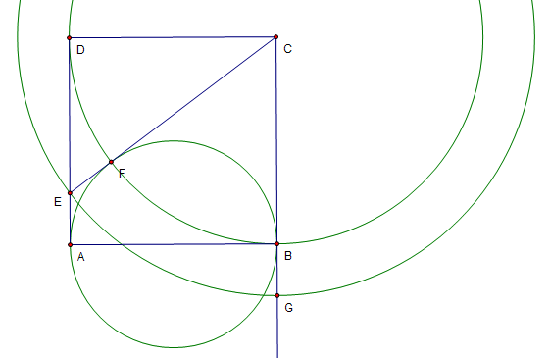2004 AMC 12A Problems/Problem 18
- The following problem is from both the 2004 AMC 12A #18 and 2004 AMC 10A #22, so both problems redirect to this page.
Problem
Square ![]() has side length
has side length ![]() . A semicircle with diameter
. A semicircle with diameter ![]() is constructed inside the square, and the tangent to the semicircle from
is constructed inside the square, and the tangent to the semicircle from ![]() intersects side
intersects side ![]() at
at ![]() . What is the length of
. What is the length of ![]() ?
?

![]()
Solution
Solution 1
Let the point of tangency be ![]() . By the Two Tangent Theorem
. By the Two Tangent Theorem ![]() and
and ![]() . Thus
. Thus ![]() . The Pythagorean Theorem on
. The Pythagorean Theorem on ![]() yields
yields

Hence ![]() .
.
Solution 2
Clearly, ![]() . Thus, the sides of right triangle
. Thus, the sides of right triangle ![]() are in arithmetic progression. Thus it is similar to the triangle
are in arithmetic progression. Thus it is similar to the triangle ![]() and since
and since ![]() ,
, ![]() .
.
See also
| 2004 AMC 12A (Problems • Answer Key • Resources) | |
| Preceded by Problem 17 |
Followed by Problem 19 |
| 1 • 2 • 3 • 4 • 5 • 6 • 7 • 8 • 9 • 10 • 11 • 12 • 13 • 14 • 15 • 16 • 17 • 18 • 19 • 20 • 21 • 22 • 23 • 24 • 25 | |
| All AMC 12 Problems and Solutions | |
| 2004 AMC 10A (Problems • Answer Key • Resources) | ||
| Preceded by Problem 21 |
Followed by Problem 23 | |
| 1 • 2 • 3 • 4 • 5 • 6 • 7 • 8 • 9 • 10 • 11 • 12 • 13 • 14 • 15 • 16 • 17 • 18 • 19 • 20 • 21 • 22 • 23 • 24 • 25 | ||
| All AMC 10 Problems and Solutions | ||










